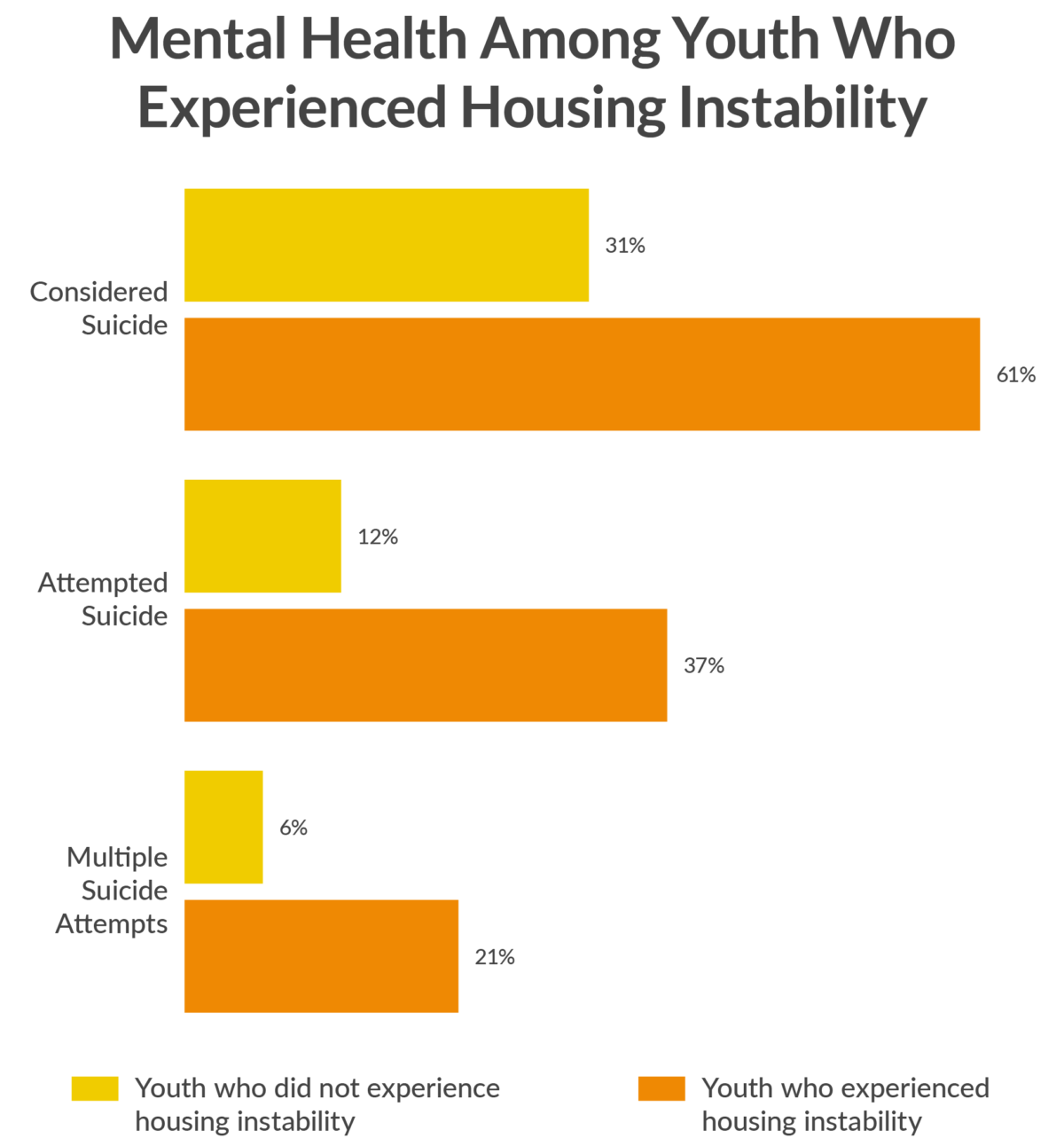Summary
The national challenge surrounding homelessness and housing instability stems from both the prevalence of youth who experience homelessness as well as the relationship between homelessness and mental and physical health (Meldow, S., Klineberg, E., Steinbeck, K., 2014). Those who experience housing instability report significantly poorer mental health outcomes (Baam, Wilson, & Russell, 2019; Ecker, Aubry, & Sylvestre, 2019), and LGBTQ youth are represented at over twice the overall youth rate in reports of unstable housing (Baams, Wilson, & Russell, 2019; Durso & Gates, 2012). This is alarming given that LGBTQ youth in general report significantly higher rates of considering and attempting suicide compared to heterosexual and/or cisgender youth (Kann et al., 2018). Despite the overrepresentation of LGBTQ youth among those experiencing housing instability, there remains a dearth of studies examining the relationship between housing instability and suicidality among LGBTQ youth. In this research brief, we explore the relationship between reports of unstable housing and recent suicidality among youth who participated in The Trevor Project’s National Survey on LGBTQ Youth Mental Health (The Trevor Project, 2019).
Results

Overall, 25% of LGBTQ youth in our sample reported experiencing unstable housing at some point in their life. LGBTQ youth who experienced housing instability were on average younger, transgender/non-binary, Hispanic or a racial minority, and from families with low income. Youth who experienced housing instability also reported higher rates of discrimination and physical threats or harm related to their sexual orientation or gender identity.
LGBTQ youth who experienced housing instability reported considering suicide at twice the rate and attempted suicide at more than three times the rate of LGBTQ youth who had not. Importantly, even after controlling for the impact of related variables, the influence of housing instability on LGBTQ youth’s experiences with suicidal ideation (OR = 2.75), suicide attempts (OR = 3.26) and multiple suicide attempts (OR = 3.07) remained significant.
Methodology
A quantitative cross-sectional design was used to collect data through an online survey platform between February and September 2018. A sample of LGBTQ youth ages 13–24 who resided in the United States were recruited via targeted ads on social media. A total of 34,808 youth consented to complete The Trevor Project’s 2019 National Survey on LGBTQ Youth Mental Health with a final analytic sample of 25,896. The current analyses focused on the 25,506 youth who provided a response to questions related to housing instability. Specifically, youth were asked “Have you ever been homeless (even if only for a short period of time)?” to assess explicit homelessness. Those who responded “No” were then asked “Have you ever had to sleep away from your parents or guardians because you were kicked out, ran away, or were abandoned?” These were combined to reflect youth’s experiences with unstable housing. Three separate logistic regression models were utilized to predict suicidality in the past 12 months (seriously considered suicide, attempted suicide, and multiple suicide attempts) while controlling for the impact of youth age, race/ethnicity, gender identity, family income, experiences with discrimination based on sexual orientation or gender identity, and having been physically threatened or harmed due to sexual orientation or gender identity.
Looking Ahead
LGBTQ youth report rates of unstable housing that are much higher than those reported among their heterosexual or cisgender peers. Our findings suggest that experiences of housing instability have a significant association with LGBTQ youth suicidality. Organizations serving youth who are homeless should be LGBTQ inclusive and affirming, especially since LGBTQ youth who report having at least one accepting adult were 40% less likely to report a suicide attempt in the past year (Green, Price-Feeney, & Dorison, 2019). Further, organizations should be equipped to provide and discuss LGBTQ-competent suicide prevention so they might be able to serve in a life-saving capacity for LGBTQ youth. The Trevor Project provides such training, advocates for policymakers to fund programs that support homeless youth, and encourages legislation that supports LGBTQ inclusive and affirming environments. An independent study found that 1 in 3 youth using our crisis services had experienced homelessness, particularly among those who disclosed their LGBTQ identity to a parent or experienced parental rejection (Rhoades, Rusow, Bond, Lanteigne, Fulginiti, & Goldbach, 2018). At The Trevor Project, our crisis services team works 24/7 to provide support for all LGBTQ youth in crisis. We also applaud the work of True Colors United and other youth-serving organizations that work tirelessly to advocate on behalf of and directly support LGBTQ youth experiencing homelessness.
| ReferencesBaams, Laura, Wilson, B.D.M, Russell, S.T. (2019). LGBTQ youth in unstable housing and foster care. Pediatrics, 143(3).e20174211Durso, L.E. & Gates, G.J. (2012). Serving our youth: Findings from a national survey of service providers working with lesbian, gay, bisexual, and transgender youth who are homeless or at risk of becoming homeless. Los Angeles: The Williams Institute with True Colors Fund and The Palette Fund.Ecker, J., Aubry, T., Sylvestre, J. (2019). A review of the literature on LGBTQ adults who experience homelessness. Journal of Homosexuality, 66 (3), 297-323.Green, A.E., Price-Feeney, M., Dorison, S. (2019). Accepting Adults Reduce Suicide Attempts Among LGBTQ Youth. New York, New York: The Trevor ProjectKann, L., McManus, T., Harris, W.A., Shanklin, S.L., Flint, K.H., Queen, B., et al. (2018). Youth risk behavior surveillance-United States, 2017. Morbidity and Mortality Weekly Report Surveillance Summaries, 67(8), 1-114.Meldow, S., Klineberg, E. Steinbeck, K. (2014). The health diagnoses of homeless adolescents: a systematic review of the literature. Journal of Adolescence, 37(5), 531-542.Rhoades, H., Rusow, J.A., Bond, D., Lanteigne, A., Fulginiti, A., Goldbach, J.T. (2018). Homelessness, mental health and suicidality among LGBTQ youth accessing crisis services. Child Psychiatry & Human Development, 49, 643-651.The Trevor Project. (2019). National Survey on LGBTQ Mental Health. New York, New York: The Trevor Project. |
For more information please contact: [email protected]
